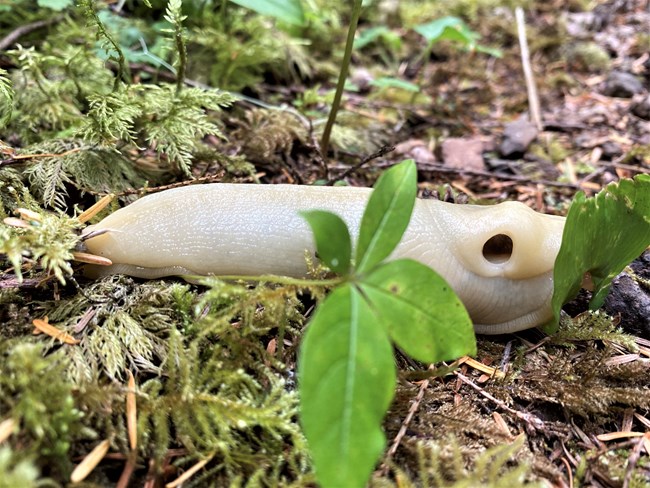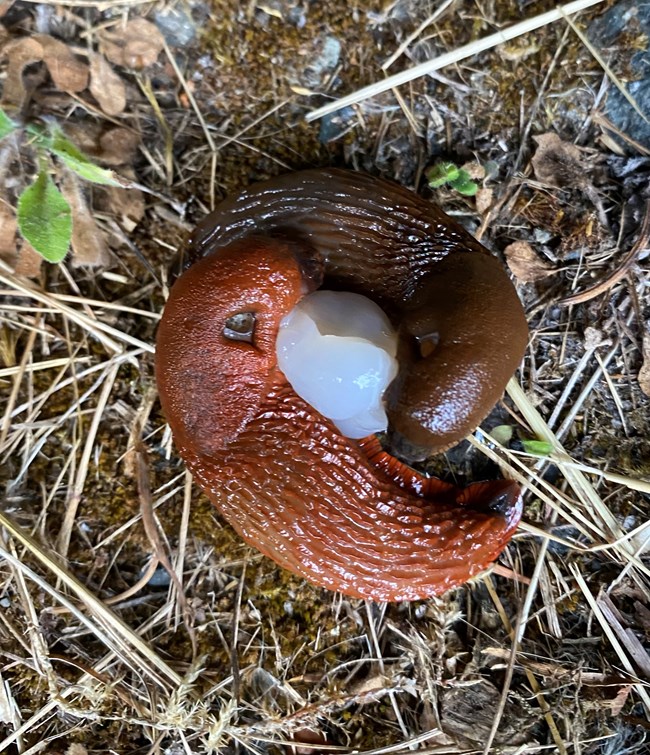|
What's with the slugs? Olympic National Park is home to many animals and thousands of invertebrates, but few have the varied reputation of a slug. Olympic is home to two types of slugs that roam the forest vegetation. Some are in awe of these creatures while others find themselves uneasy around them. Whatever the reaction, these animals have made a name for themselves in the world from the complicated web of life to popular culture of the PNW! The Banana Slug is a native resident that has become an iconic symbol of the Pacific Northwest, including being the official mascot of UC Santa Cruz. The non-native European Slug is now also common within the lush, damp forest ecosystems of the park. 
Margo Roseum Do banana slugs look like bananas? Banana slugs (Ariolimax columbianus) can vary in color from bright yellow to dark yellow, as well as mixtures of brown, black, white, and green. Many even have dark brown or black spots! These slugs have a smooth head and a smooth body. Many boast a distinct ridge that runs along the length of the back. 
Margo Roseum and Karl Rand How can I tell the difference between the slugs? European slugs (Arion rufus) can also vary in color, making identification confusing at times. These slugs also inhabit the forests of Olympic, although they are actually non-native. These slugs are typically black, brown or red and have ridges along their back side. Compare the images and descriptions of the these two European Slugs. 
Margo Roseum What’s with the slime? Over 12 feet of rain per year on average gives the perfect backdrop for a slime coated animal like this. The moist forest floor and their slime help them to breathe, move, and survive! The slime keeps them from drying out, as does the damp ecosystem of the temperate rainforest along the western coast from central California to Southeast Alaska. Especially after a rain, one may also see the slug’s stoma open on the side of its head, helping it to breathe. What do slugs eat? It’s common to see these slugs on the trail, on tree trunks, along ferns, and eating leaves and mushrooms as they help to decompose materials with up to 27,000 radula, or microscopic teeth! As decomposers, they help to return energy to the earth. How can we, as visitors and stewards to the park help save energy? We can turn out lights, reuse and recycle!
What are their relatives? Banana slugs are mollusks. We have a number of other mollusks in Olympic including mussels, snails, and octopuses! In the rainforest, you may see slugs and snails. Be sure to not confuse the two by looking for their main difference: a shell. Snails have shells that help to protect them from predators. 
Margo Roseum How do they reproduce? Slugs are hermaphrodites, meaning that they each have both male and female reproductive organs. Therefore, while mating, one or both slugs can become impregnated. In extreme cases, although uncommon and less preferred, a slug could impregnate itself. The pregnant slug will then lay 3-50 eggs in a safe and secluded place. In just 1-2 months, the babies will emerge, looking like any other slug, although often a paler color, and growing quickly to their maturity in just a few months. Remember that if you are exploring the forest, to stay on the trails and always put back rocks and logs, as they are important homes and shelters for animals that live in this ecosystem! Where can they be found? Banana slugs love the moist environments that dominate the Pacific Northwest. On a damp morning, during a light rain, or after a storm when the humidity is high are great times to look for slugs, but they can be found all year long exploring the forest floors and even venturing onto stumps and trees to eat. Banana slugs are especially well-known in the wettest parts of the park such as the Hoh Rainforest and Quinault Rainforest ecosystems. No matter where they are, they are an important component of the forests of Olympic! |
Last updated: September 6, 2020
